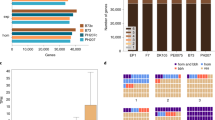Abstract
Previous studies of genome size in inbreds and hybrids had revealed that in some combinations the genome size in hybrids deviates from the midparent value of the parents. We examined whether repetitive sequence arrays such as knob heterochromatin, centromere repeats and ribosomal RNAs, as visualized cytologically in root tip chromosome spreads, would reveal any changes in copy number in such hybrids. The results indicate that no obvious changes in copy number are observed. Thus, the mechanisms by which repetitive arrays change copy number seem unrelated to the hybrid effect. Moreover, the hybrid genome effect is not manifested in gross changes in the most common repetitive sequences in the genome as determined in root tip spreads.






Similar content being viewed by others
References
Han F, Fedak G, Ouellet T, Liu B (2003) Rapid genomic changes in interspecific and intergeneric hybrids and allopolyploids in Triticeae. Genome 46:716–723
Han F, Liu B, Fedak G, Liu B (2004) Genomic constitution and variation in five partial amphiploids of wheat-Thinopyrum intermedium as revealed by GISH, multicolor GISH and seed storage protein analysis. Theor Appl Genet 109:1070–1076
Han F, Fedak G, Guo W, Liu B (2005) Rapid and repeatable elimination of a parental genome-specific DNA repeat (pGc1R-1a) in newly synthesized wheat allopolyploids. Genetics 170:1239–1245
Jin W, Melo JR, Nagaki K et al (2004) Maize centromeres: organization and functional adaptation in the genetic background of oat. Plant Cell 16:571–581
Kato A (1999) Air drying method using nitrous oxide for chromosome counting in maize. Biotech Histochem 3:160–166
Kato A, Albert PS, Vega JM, Birchler JA (2006) Sensitive FISH signal detection using directly labeled probes produced by high concentration DNA polymerase nick translation in maize. Biotech Histochem 81:71–78
Kato A, Lamb JC, Birchler JA (2004) Chromosome painting using repetitive DNA sequence as probes for somatic chromosome identification in maize. Proc Natl Acad Sci U S A 101:13554–13559
Lamb JC, Danilova T, Bauer MJ et al (2007) Single gene detection and karyotyping using small target FISH on maize somatic chromosomes. Genetics 175:1047–1058
Laurie DA, Bennett MD (1985) Nuclear DNA content in the genera Zea and Sorghum. Intergeneric, interspecific and intraspecific variation. Heredity 55:307–313
Ma X, Fang P, Gustafson P (2004) Polyploidization-induced genome variation in Triticale. Genome 47:839–848
Ozkan H, Levy AA, Feldman M (2001) Allopolyploidy-induced rapid genome evolution in the wheat (Aegilops-Triticum) group. Plant Cell 13:1735–1747
Rayburn AL, Biradar DP, Bullock DG, McMurphy LM (1993) Nuclear DNA content in F1 hybrids of maize. Heredity 70:294–300
Rayburn AL, Price HJ, Smith JD, Gold JR (1985) C-band heterochromatin and DNA content variation in Zea mays. Am J Bot 72:1133–1138
Ream TS, Strobel J, Roller B et al (2005) A test for ectopic exchange catalyzed by Cre recombinase in maize. Theor Appl Genet 111:378–385
Rivin CJ, Cullis CA, Walbot V (1986) Evaluating quantitative variation in the genome of Zea mays. Genetics 113:1009–1019
Shaked H, Kashkush K, Ozkan H et al (2001) Sequence elimination and cytosine methylation are rapid and reproducible responses of the genome to wide hybridization and allopolyploidy in wheat. Plant Cell 13:1749–1759
Yu W, Han F, Kato A, Birchler JA (2006) Characterization of a maize isochromosome 8S*8S. Genome 49:700–706
Yu W, Lamb JC, Han F, Birchler JA (2007) Cytological visualization of DNA transposons and their transposition pattern in somatic cells of maize. Genetics 175:31–39
Acknowledgements
Research on this topic in our laboratory is funded by NSF grants DBI 041671 and DBI 0423898.
Author information
Authors and Affiliations
Corresponding author
Rights and permissions
About this article
Cite this article
Birchler, J.A., Albert, P.S. & Gao, Z. Stability of Repeated Sequence Clusters in Hybrids of Maize as Revealed by FISH. Tropical Plant Biol. 1, 34–39 (2008). https://doi.org/10.1007/s12042-007-9001-y
Published:
Issue Date:
DOI: https://doi.org/10.1007/s12042-007-9001-y




